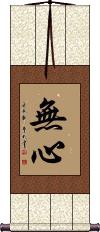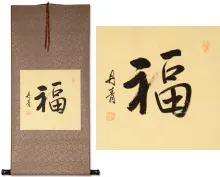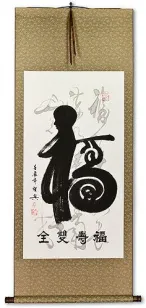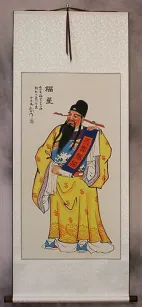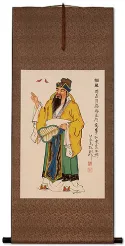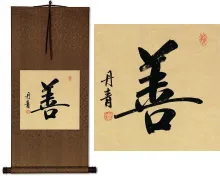Many custom options...
And formats...

Distinguish Good and Evil in Chinese / Japanese...
Buy a Distinguish Good and Evil calligraphy wall scroll here!
Personalize your custom “Distinguish Good and Evil” project by clicking the button next to your favorite “Distinguish Good and Evil” title below...
Distinguish Good and Evil
Good and Evil
Buddha Heart / Mind of Buddha
佛心 means the Buddha's mind, Buddha-heart, or the spiritually enlightened heart/mind.
The Buddha Heart is detached from good and evil and other such constructs. The Buddha Heart has mercy, compassion, and loving-kindness for all sentient life, the good, the wicked, and all in between.
The heart and mind (心) are the same concepts in the ancient Orient, so you can use heart and mind interchangeably in this context.
No Mind / Mushin
In Japanese, 無心 means innocent or without knowledge of good and evil. It literally means “without mind.”
無心 is one of the five spirits of the warrior (budo) and is often used as a Japanese martial arts tenet. Under that context, places such as the Budo Dojo define it this way: “No mind, a mind without ego. A mind like a mirror which reflects and dos not judge.” The original term was “mushin no shin,” meaning “mind of no mind.” It is a state of mind without fear, anger, or anxiety. Mushin is often described by the phrase “Mizu no Kokoro,” which means “mind like water.” The phrase is a metaphor describing the pond that clearly reflects its surroundings when calm but whose images are obscured once a pebble is dropped into its waters.
This has a good meaning in conjunction with Chan / Zen Buddhism in Japan. However, out of that context, it means mindlessness or absent-mindedness. To non-Buddhists in China, this is associated with doing something without thinking.
In Korean, this usually means indifference.
Use caution and know your audience before ordering this selection.
More info: Wikipedia: Mushin
This in-stock artwork might be what you are looking for, and ships right away...
Gallery Price: $31.00
Your Price: $16.88
Gallery Price: $65.00
Your Price: $39.88
Gallery Price: $90.00
Your Price: $49.88
Good Fortune / Prosperity Saint Wall Scroll
Discounted Blemished
Gallery Price: $71.00
Your Price: $39.00
Good Luck Special Calligraphy Wall Scroll
Discounted Blemished
Gallery Price: $53.00
Your Price: $29.00
Handmade Good Luck Special Calligraphy Wall Scroll
Discounted Blemished
Gallery Price: $35.00
Your Price: $19.00
Unique Good Luck Special Calligraphy Wall Scroll
Discounted Blemished
Gallery Price: $31.00
Your Price: $17.00
Decorative Good Luck Special Calligraphy Wall Scroll
Discounted Blemished
Gallery Price: $31.00
Your Price: $17.00
Gallery Price: $65.00
Your Price: $39.88
Not the results for distinguish good and evil that you were looking for?
Below are some entries from our dictionary that may match your distinguish good and evil search...
| Characters If shown, 2nd row is Simp. Chinese |
Pronunciation Romanization |
Simple Dictionary Definition |
彰善癉惡 彰善瘅恶 see styles |
zhāng shàn dàn è zhang1 shan4 dan4 e4 chang shan tan o |
More info & calligraphy: Distinguish Good and Evil |
佛心 see styles |
fó xīn fo2 xin1 fo hsin busshin |
More info & calligraphy: Buddha Heart / Mind of BuddhaThe mind of Buddha, the spiritually enlightened heart. A heart of mercy; a heart abiding in the real, not the seeming; detached from good and evil and other such contrasts. |
善悪不二 see styles |
zenakufuni ぜんあくふに |
More info & calligraphy: Good and Evil |
七曜 see styles |
qī yào qi1 yao4 ch`i yao chi yao shichiyou / shichiyo しちよう |
the seven planets of premodern astronomy (the Sun, the Moon, Mercury, Venus, Mars, Jupiter, and Saturn) (1) {astron} the seven luminaries (sun, moon, Mercury, Venus, Mars, Jupiter and Saturn); (2) the seven days of the week The seven brilliant ones — the sun and moon, together with the five planets which are connected with fire, water, wood, metal, and earth. Their essence shines in the sky, but their spirits are over men as judges of their good and evil, and as rulers over good and evil fortune. The following list shows their names in Chinese and Sanskrit: Sun 日, 太陽; aditya 阿彌底耶 Moon月, 太陰; soma 蘇摩 Mars火星, 勢惑勞; aṅgāraka 盎哦囉迦 Mercury水星, 辰星; budha 部陀 Jupiter木星, 歳星; bṛhaspati 勿哩訶娑跛底 Venus金星, 太白; śukra 戌羯羅 Saturn土星, 鎭星; śanaiścara 賖乃以室折羅. |
三識 三识 see styles |
sān shì san1 shi4 san shih sanshiki |
The three states of mind or consciousness: 眞識 the original unsullied consciousness or Mind, the tathāgatagarbha, the eighth or ālaya 阿賴耶識 ; 現識 mind or consciousness diversified in contact with or producing phenomena, good and evil; 分別識 consciousness discriminating and evolving the objects of the five senses. Also 意識 manas, 心識 ālaya, and 無垢識 amala, v. 識. |
不二 see styles |
bù èr bu4 er4 pu erh fuji ふじ |
the only (choice, way etc); undivided (loyalty) {Buddh} advaitam (non-duality); (surname, female given name) Fuji advaya. No second, non-duality, the one and undivided, the unity of all things, the one reality、 the universal Buddha-nature. There are numerous combinations, e. g. 善惡不二 good and evil are not a dualism: nor are 有 and 空 the material and immaterial, nor are 迷 and 悟 delusion and awareness— all these are of the one Buddha-nature. |
二因 see styles |
èr yīn er4 yin1 erh yin niin / nin にいん |
{Buddh} two causes Two causes, of which there are various definitions: (1) 生因 The producing cause (of all good things); and 了因 the revealing or illuminating cause i.e. knowledge, or wisdom. (2) 能生因 The 8th 識 q. v.: the cause that is able to produce all sense and perceptions, also all good and evil; and 方便因 the environmental or adaptive cause, which aids the 8th 識, as water or earth does the seed, etc. (3) 習因 or 同類因 Practice or habit as cause e. g. desire causing desire; and 報因 or 果熟因 the rewarding cause, or fruit-ripening cause, e. g. pleasure or pain caused by good or evil deeds. (4) 正因 Correct or direct cause i.e. the Buddha-nature of all beings; and 緣因 the contributory cause, or enlightenment (see 了因 above) which evolves the 正因 or Buddha-nature by good works. (5) 近因 Immediate or direct cause and 遠因 distant or indirect cause or causes. |
二業 二业 see styles |
èr yè er4 ye4 erh yeh nigyou / nigyo にぎょう |
(archaism) restaurants and geisha establishments Two classes of karma. (1) (a) 引業 leads to the 總報, i.e. the award as to the species into which one is to be born, e.g. men, gods, etc.; (6) 滿業 is the 別報 or fulfillment in detail, i.e. the kind or quality of being e.g. clever or stupid, happy or unhappy, etc. (2) (a) 善業 and (b) 惡業 Good and evil karma, resulting in happiness or misery. (3) (a) 助業 Aids to the karma of being reborn in Amitābha's Pure—land e. g. offerings, chantings, etc.; (b) 正業 thought and invocation of Amitābha with undivided mind, as the direct method. |
五蘊 五蕴 see styles |
wǔ yùn wu3 yun4 wu yün goun / gon ごうん |
the Five Aggregates (from Sanskrit "skandha") (Buddhism) {Buddh} the five skandhas (matter, sensation, perception, mental formations and consciousness); the five aggregates The five skandhas, pañca-skandha: also 五陰; 五衆; 五塞犍陀 The five cumulations, substances, or aggregates, i. e. the components of an intelligent being, specially a human being: (1) 色 rūpa, form, matter, the physical form related to the five organs of sense; (2) 受 vedana, reception, sensation, feeling, the functioning of the mind or senses in connection with affairs and things; (3) 想 saṃjñā, conception, or discerning; the functioning of mind in distinguishing; (4) 行 saṃskāra, the functioning of mind in its processes regarding like and dislike, good and evil, etc.; (5) 識 vijñāna, mental faculty in regard to perception and cognition, discriminative of affairs and things. The first is said to be physical, the other four mental qualities; (2), (3), and (4) are associated with mental functioning, and therefore with 心所; (5) is associated with the faculty or nature of the mind 心王 manas. Eitel gives— form, perception, consciousness, action, knowledge. See also Keith's Buddhist Philosophy, 85-91. |
凡習 凡习 see styles |
fán xí fan2 xi2 fan hsi bonshū |
The practices, good and evil, of commom ,or unconverted men. |
十力 see styles |
shí lì shi2 li4 shih li jūriki |
Daśabala. The ten powers of Buddha, giving complete knowledge of: (1) what is right or wrong in every condition; (2) what is the karma of every being, past, present, and future; (3) all stages of dhyāna liberation, and samādhi; (4) the powers and faculties of all beings; (5) the desires, or moral direction of every being; (6) the actual condition of every individual; (7) the direction and consequence of all laws; (8) all causes of mortality and of good and evil in their reality; (9) the end of all beings and nirvāṇa; (10) the destruction of all illusion of every kind. See the 智度論 25 and the 倶舍論 29. |
善悪 see styles |
zenaku ぜんあく |
right and wrong; good and evil |
善惡 善恶 see styles |
shàn è shan4 e4 shan o zenmaku |
good and evil; good versus evil Good and evil; good, inter alia, is defined as 順理, evil as 違理; i.e. to accord with, or to disobey the right. The 十善十惡 are the keeping or breaking of the ten commandments. |
四業 四业 see styles |
sì yè si4 ye4 ssu yeh shi gō |
four types of admixture of good and evil karma |
地藏 see styles |
dì zàng di4 zang4 ti tsang jizou / jizo じぞう |
Kṣitigarbha, the Bodhisattva of the Great Vow (to save all souls before accepting Bodhi); also translated Earth Treasury, Earth Womb, or Earth Store Bodhisattva (surname) Jizou Ti-tsang, J. Jizō, Kṣitigarbha, 乞叉底蘗沙; Earth-store, Earth-treasury, or Earthwomb. One of the group of eight Dhvani- Bodhisattvas. With hints of a feminine origin, he is now the guardian of the earth. Though associated with Yama as overlord, and with the dead and the hells, his role is that of saviour. Depicted with the alarum staff with its six rings, he is accredited with power over the hells and is devoted to the saving of all creatures between the nirvana of Śākyamuni and the advent of Maitreya the fifth century he has been especially considered as the deliverer from the hells. His central place in China is at Chiu-hua-shan, forty li south-west of Ch'ing-yang in Anhui. In Japan he is also the protector of travellers by land and his image accordingly appears on the roads; bereaved parents put stones by his images to seek his aid in relieving the labours of their dead in the task of piling stones on the banks of the Buddhist Styx; he also helps women in labour. He is described as holding a place between the gods and men on the one hand and the hells on the other for saving all in distress; some say he is an incarnation of Yama. At dawn he sits immobile on the earth 地 and meditates on the myriads of its beings 藏. When represented as a monk, it may be through the influence of a Korean monk who is considered to be his incarnation, and who came to China in 653 and died in 728 at the age of 99 after residing at Chiu-hua-shan for seventy-five years: his body, not decaying, is said to have been gilded over and became an object of worship. Many have confused 眞羅 part of Korea with 暹羅 Siam. There are other developments of Ti-tsang, such as the 六地藏 Six Ti-tsang, i. e. severally converting or transforming those in the hells, pretas, animals, asuras, men, and the devas; these six Ti-tsang have different images and symbols. Ti-tsang has also six messengers 六使者: Yama for transforming those in hell; the pearl-holder for pretas; the strong one or animals; the devīof mercy for asuras; the devī of the treasure for human beings; one who has charge of the heavens for the devas. There is also the 延命地藏 Yanming Ti-tsang, who controls length of days and who is approached, as also may be P'u-hsien, for that Purpose; his two assistants are the Supervisors of good and evil 掌善 and 掌惡. Under another form, as 勝軍地藏 Ti-tsang is chiefly associated with the esoteric cult. The benefits derived from his worship are many, some say ten, others say twenty-eight. His vows are contained in the 地藏菩薩本願經. There is also the 大乘大集地藏十電經 tr. by Xuanzang in 10 juan in the seventh century, which probably influenced the spread of the Ti-tsang cult. |
娑婆 see styles |
suō pó suo1 po2 so p`o so po shaba; shaba しゃば; シャバ |
(1) this world; this life; (2) (kana only) (colloquialism) the free world (outside of prison, the army, red light district, etc.); (3) {Buddh} this corrupt world; present world sahā; that which bears, the earth, v. 地; intp. as bearing, enduring; the place of good and evil; a universe, or great chiliocosm, Where all are subject to transmigration and which a Buddha transforms; it is divided into three regions 三界 and Mahābrahmā Sahāmpati is its lord. Other forms: 娑婆世界; 娑界; 娑媻; 娑訶; 沙訶; 索訶. |
定異 定异 see styles |
dìng yì ding4 yi4 ting i jōi |
distinction of good and evil (causes) |
尅識 尅识 see styles |
kè shì ke4 shi4 k`o shih ko shih kokushiki |
The certainty of the knowledge (by the sprits, of men's good and evil). |
心田 see styles |
xīn tián xin1 tian2 hsin t`ien hsin tien shinden しんでん |
heart (one's innermost being) (given name) Shinden The field of the mind, or heart, in which spring up good and evil. |
性具 see styles |
xìng jù xing4 ju4 hsing chü seigu / segu せいぐ |
sex toy; sex aid The Tiantai doctrine that the Buddha-nature includes both good and evil; v. 觀音玄義記 2. Cf. 體具; 理具 of similar meaning. |
曲直 see styles |
qū zhí qu1 zhi2 ch`ü chih chü chih maganao まがなお |
lit. crooked and straight; fig. right and wrong, good and evil merits (of a case); right or wrong; (surname) Maganao |
業力 业力 see styles |
yè lì ye4 li4 yeh li gōriki |
(Buddhism) karma The power of karma to produce good and evil fruit. |
業秤 业秤 see styles |
yè chèng ye4 cheng4 yeh ch`eng yeh cheng gō no hakari |
The scales of karma, in which good and evil are weighed by the rulers of Hades. |
殃福 see styles |
yāng fú yang1 fu2 yang fu ōfuku |
good and evil fortune |
清濁 see styles |
seidaku / sedaku せいだく |
(1) good and evil; purity and impurity; (2) {ling} voiced and unvoiced consonants |
無表 无表 see styles |
wú biǎo wu2 biao3 wu piao muhyō |
avijñapti. Unconscious, latent, not expressed, subjective, e.g. 'the taking of a religious vow impresses on a man's character a peculiar bent,' Keith. This is internal and not visible to others. It has a 'quasi-material' basis styled 無表色 or 無作色 which has power to resist evil. It is the Sarvāstivādin view, though certain other schools repudiated the material basis and defined it as mental. This invisible power may be both for good and evil, and may perhaps be compared to 'animal magnetism' or hypnotic powers. It means occult: power whether for higher spiritual ends or for base purposes. |
白黑 see styles |
bái hēi bai2 hei1 pai hei byakukoku |
white and dark, e. g. 白黑業 good and evil deeds, or karma. |
白黒 see styles |
shirokuro しろくろ |
(noun - becomes adjective with の) (1) black and white; monochrome; (2) good and evil; right and wrong; guilt and innocence |
禍福 祸福 see styles |
huò fú huo4 fu2 huo fu kafuku かふく |
disaster and happiness fortune and misfortune; prosperity and adversity; good and evil; weal and woe misfortune and fortune |
總持 总持 see styles |
zǒng chí zong3 chi2 tsung ch`ih tsung chih sōji |
dhāraṇī, cf. 陀, entire control, a tr. of the Sanskrit word, and associated with the Yogācārya school; absolute control over good and evil passions and influences. |
Click here for more distinguish good and evil results from our dictionary
The following table may be helpful for those studying Chinese or Japanese...
| Title | Characters | Romaji (Romanized Japanese) | Various forms of Romanized Chinese | |
| Distinguish Good and Evil | 彰善癉惡 彰善瘅恶 | zhāng shàn dàn è zhang1 shan4 dan4 e4 zhang shan dan e zhangshandane | chang shan tan o changshantano |
|
| Good and Evil | 善悪不二 | zenakufuni | ||
| Buddha Heart Mind of Buddha | 佛心 | busshin / bushin | fó xīn / fo2 xin1 / fo xin / foxin | fo hsin / fohsin |
| No Mind Mushin | 無心 无心 | mu shin / mushin | wú xīn / wu2 xin1 / wu xin / wuxin | wu hsin / wuhsin |
| In some entries above you will see that characters have different versions above and below a line. In these cases, the characters above the line are Traditional Chinese, while the ones below are Simplified Chinese. | ||||
Successful Chinese Character and Japanese Kanji calligraphy searches within the last few hours...



